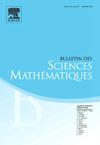Inequalities for eigenvalues of the poly-Laplacian with arbitrary order on spherical domains
IF 0.9
3区 数学
Q2 MATHEMATICS, APPLIED
引用次数: 0
Abstract
In this paper, we are devoted to the study of universal inequalities for eigenvalues of the poly-Laplacian with arbitrary order on bounded domains in , respectively, and then establish some new universal inequalities that are different from those already present in the literature. In particular, our results can reveal the relationship between the -th eigenvalue and the first k eigenvalues relatively quickly, and some methods used in this paper might be applied to other eigenvalue problems.
球面上任意阶多拉普拉斯特征值的不等式
本文分别研究了Sn(1)中有界域上任意阶多拉普拉斯算子的特征值的一般不等式,并建立了一些不同于已有文献的新的一般不等式。特别是,我们的结果可以较快地揭示第(k+1)个特征值与前k个特征值之间的关系,并且本文的一些方法可以应用于其他特征值问题。
本文章由计算机程序翻译,如有差异,请以英文原文为准。
求助全文
约1分钟内获得全文
求助全文
来源期刊
CiteScore
1.90
自引率
7.70%
发文量
71
审稿时长
6-12 weeks
期刊介绍:
Founded in 1870, by Gaston Darboux, the Bulletin publishes original articles covering all branches of pure mathematics.

 求助内容:
求助内容: 应助结果提醒方式:
应助结果提醒方式:


